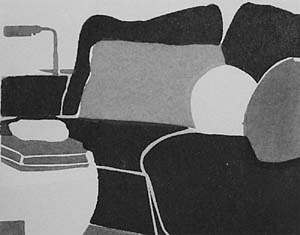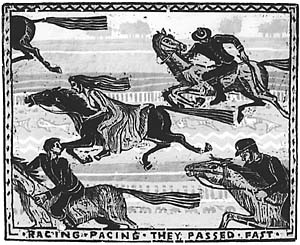
 |
Summer 2003 |
|
An interview with Denise Giardina ADA: Becoming Accessible From the Director A convergence of printmakers and potters Monoprints of Barbara Marsh Wilson Interview with Mark Wolfe |
Collective Impressions
|
 |
Printmaker Jan Griffin exhibits her “Interior Landscapes,” part of a 40-piece series of silkscreen prints. “Each edition was very small (under 24 prints) and they were each four inches by four inches. They originally depicted cozy places in which one could curl up with a good book. Toward the end of the series, I began to incorporate figures in the designs and Anna Bell Li was the last in the series and was a portrait.” “Interior Landscape #26,” one of Jan Griffin’s Interior Landscapes series of silk screen prints. |
Griffin discovered the medium of silk screen many years ago by chance. Providence was working overtime. “Having spent more than 30 years with silk screen work, I still find it exciting and challenging. Tiring of the restrictions of miniatures, I have recently turned to larger formats. The recently completed, ‘The Ayes Have It’ screen print is 24 inches by 36 inches, and required 78 separate screens and nine weeks of intensive work.” This work was scheduled for exhibit at the Clay Center’s inaugural opening.
Griffin’s studio, Sassafrolly Print Studio, is “open to students where they may use a small etching press for watercolor monotypes, as well as several types of printmaking methods.”
|
Graphic designer and printmaker Mary Grassell makes “hand-pulled” wood block prints that express some of the self-reflective questioning of contemporary life. “I am interested in color, design of composition and the storytelling aspect of the medium,” Grassell said. “They Passed Fast,” a color woodblock print by printmaker and designer Mary Grassell. This print, an allegory of life passing by quickly, was accepted for a juried exhibition that was part of the Three Rivers Arts Festival. |
 |
A graduate of Carnegie Mellon University and Syracuse University, Grassell now teaches art at Marshall University. Since her professional career began, she has spent and continues to spend part of her life in the world of commercial graphic art.
For her this is no contradiction. “I am a printmaker by choice (or should I say, in addition to being a designer) because the two areas of art are so absolutely related. Both printmaking and design depend upon a mechanical process to complete the art, and those mechanics must be considered and planned, but are essentially unpredictable in their results. Both result in multiple images and both are marvelous mediums for telling a story and spreading a message to many. These are the reasons I love to create prints. These are the reasons I love creating graphic design.”
Peter Massing studied printmaking at Ohio State University. Since 1989 he has been an associate professor in printmaking and drawing at Marshall University.
Massing described his relationship to his work: “Process is the motivating force behind my creativity. Images I develop document the process. I find printmaking most gratifying because it raises my consciousness about the changes that direct my energy during various states of developing an image.
“I play games, create problems to solve, stimulate ideas, impose limitations, and try to manipulate the things that are out of my control. I am challenged by the variables involved and am continuously learning how to give and how to take, and when to let what happens guide my direction.”
Massing’s etchings, lithographs and mixed media prints have a Northern Renaissance feel about them. They are meditative and expressive. “I find great pleasure in mark-making and drawing. The physical characteristic of cutting, scraping, scratching and burnishing satisfy my amusement with mark-making. I like to explore a variety of media to obtain a feeling that will define my actions during the process.”
In addition to his duties as a teacher, Massing has curated exhibits, coordinated visiting artist exhibitions and workshops at Marshall, and conducted summer printmaking workshops.
Regarding the Collective Expressions exhibit, Massing said, “The interesting thing about this opportunity is that printmakers in particular are often working collectively in a region or print shop/studio with one another, and like to collaborate with one another and share experiences. I personally find printmaking to be a collaborative experience for groups sharing space and presses, etc. It’s ‘good for the soul’ to share the tools of the trade, so to speak.”
For information about other events and exhibits at Stifel Fine Arts Center, call 304-242-7700 or 888-696-4283. The museum is located at 1330 National Road in Wheeling, WV. Contact writer Bonnie Fuoco at: [email protected].